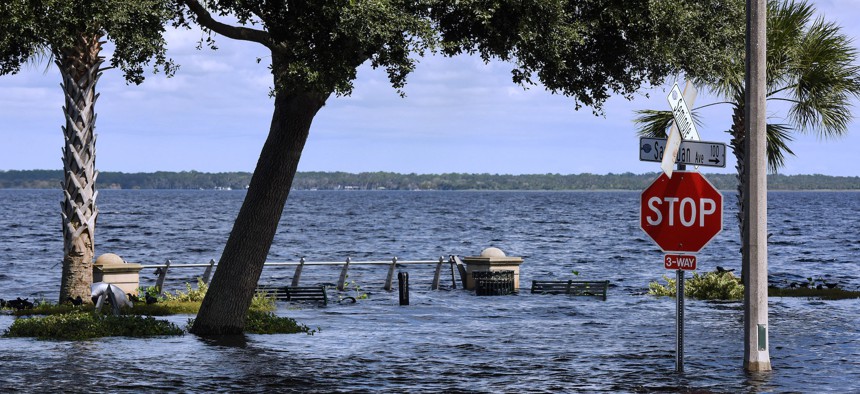Different Risks, One Crisis

Sidewalk benches are seen underwater at the Sanford Riverwalk as the St. Johns River reaches major flood stage, causing Lake Monroe to breach the sea wall in the aftermath of Hurricane Ian in downtown Sanford. Pauln Hennessy/SOPA Images/LightRocket via Getty Images
COMMENTARY | Across the U.S., communities experience climate change in different ways. But the health consequences and destruction from another summer of storms, floods, fires and drought, underscore why it’s time for collective action.
Another summer has gone by and with it more record-breaking weather events. Fueled by a changing climate this summer saw worsening droughts, extreme heat and wildfires. And the catastrophic destruction caused by Hurricanes Fiona and Ian will force communities in Puerto Rico and Florida to undergo a long recovery process.
These extreme weather events are a critical reminder that despite the historic passage of the Inflation Reduction Act, we’ve only started to address the health harms of climate change and prevent it from growing even worse.
When I was the director of emergency preparedness and response for the Los Angeles County Department of Public Health, we called emergencies like climate change a chronic crisis. They are persistent and, in the case of climate change, affect virtually everyone in the US. In a recent national poll, from Harvard T.H. Chan School of Public Health, NPR and the Robert Wood Johnson Foundation (RWJF), where I serve as chief science officer, nearly four in five Americans said they have been personally affected by extreme weather events in the past five years. Of those who experienced these events, one in four said it caused serious health problems for someone in their household.
Making matters worse is that the neighborhoods that are most vulnerable are more likely to be home to people of color. Generations of policies and practices that have led to financial disinvestments, deepened neighborhood segregation and depleted greenspace have resulted in serious racial disparities in who is experiencing the greatest impacts from the changing climate.
The Harvard-NPR-RWJF poll found that more than half of Native Americans and three in 10 Black, Latino or Asian adults reported experiencing serious health problems after an extreme weather event, compared to 18% of white adults.
The bit of hope we can pull from this poll is that when people experience extreme weather events, they are far more likely to view climate change as a crisis—and support further actions in response. Seventy-seven percent of people who have been affected by extreme weather in the past five years said climate change was a crisis or a major problem, versus 46% of people who said they have not experienced an extreme weather event.
As these extreme weather events are occurring with greater strength and frequency, people have become used to them, making it difficult to build momentum for collective action to address the climate challenge. Relatedly, not all communities face the exact same risks and as a result the urgency isn’t the same. Consider the different experiences for people living in an air-conditioned home on a tree-lined residential street with those living near pollution-spewing oil refineries in a lower-income neighborhood where many can’t afford air conditioning. In both cases, you’ll feel and be affected by extreme heat, but in the second case, your circumstances—more air pollution and fewer cooling trees—put you at greater risk.
We must find ways to help people feel connected to one another in these crises, even if we don’t all face the exact same risks. We need to make clear that these different challenges in different communities—whether it’s a wildfire in California, a 1,000-year flash flood in Kentucky, or Hurricanes Fiona and Ian in the Southeast—are part of one larger shared story. Only then will we have a sense of collective action that is required to fully tackle climate change.
Recent legislation like the Inflation Reduction Act or last year’s Bipartisan Infrastructure Law provide unique resources and opportunities to help those most vulnerable to climate change and protect their health.
Importantly, each community can tailor their response to their unique needs. For a coastal city, that may mean investing in trees and parks that help cool neighborhoods, protect against flash floods, and keep greenhouse gases out of the air. In a Midwestern community, improved farming practices may prevent dangerous algal blooms, make our food system more resilient, and reduce greenhouse gas emissions from farming.
As communities leverage these federal funds, it’s important that business, philanthropy, community organizations and governments come together to act. And we need to start by listening and investing in those at most risk on the frontlines of climate change.
We have a choice. By choosing to stay together and take more collective action that prioritizes serving those at greatest risk, we can find a path to a healthier, more stable future for ourselves, our children and families, our communities, our country and our world.
Alonzo Plough, PhD, MPH, is the chief science officer of the Robert Wood Johnson Foundation and former director of emergency preparedness and response for the Los Angeles County Department of Public Health.
NEXT STORY: How the Costs of Disasters like Hurricane Ian are Calculated – and Why it Takes so Long to Add Them Up





